ベアトリス・ゴンザレス
Beatriz González
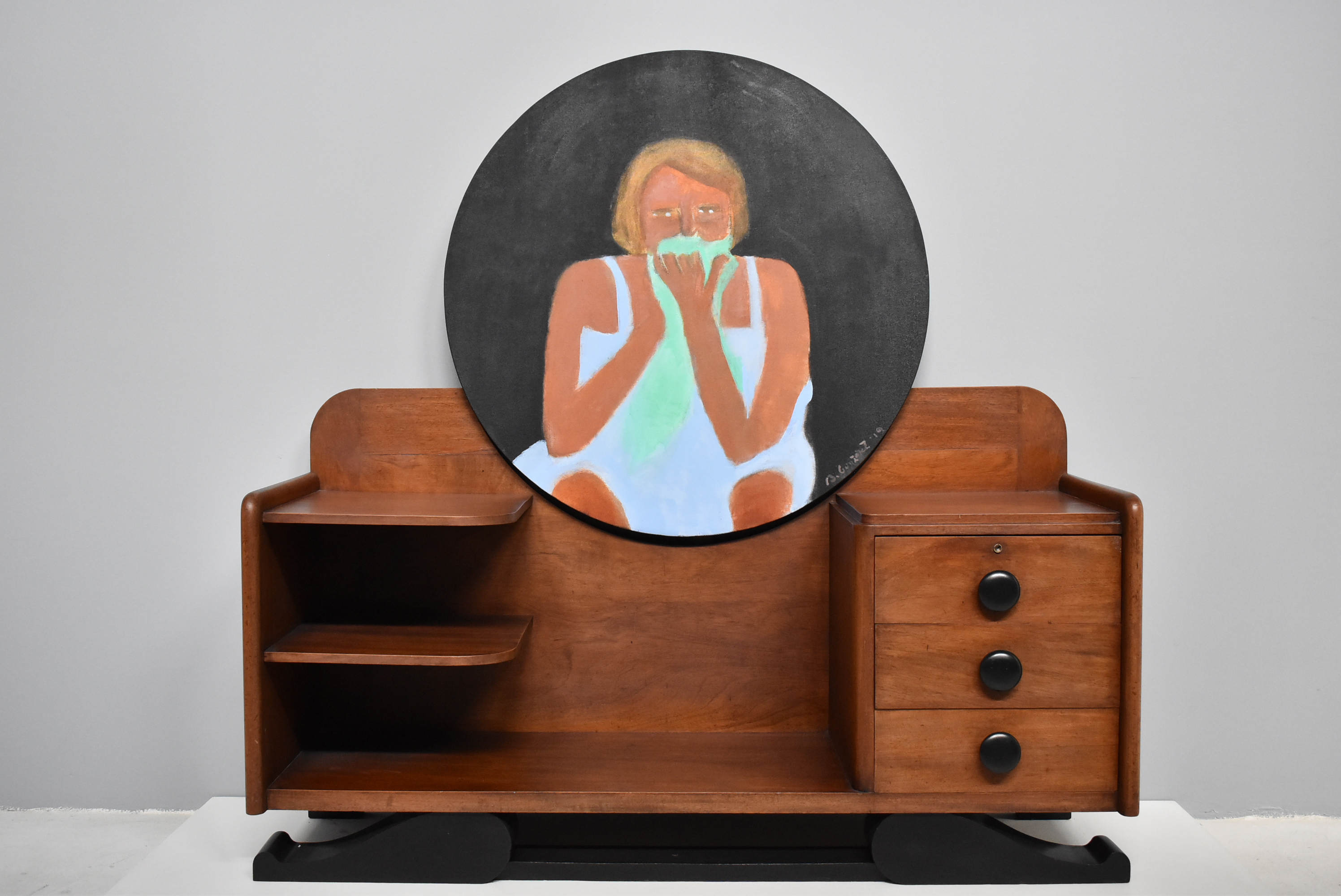
悲嘆に直面して
2019年
油彩、キャンバス、木製家具
145×152×48 cm
作家蔵
Ante el duelo (In the Face of Mourning)
2019
Oil on canvas and wooden furniture
145 x 152 x 48 cm
Collection of the artist
Courtesy: Casas Riegner, Bogotá
悲嘆に直面して
2019年
油彩、キャンバス、木製家具
145×152×48 cm
作家蔵
鏡台の本来は鏡があるべき場所に円形の油彩画が取り付けられています。絵の中には女性がひとりで腰を下ろし、ハンカチを手にすすり泣く様子が描かれています。女性の姿は、反政府左翼ゲリラ組織のコロンビア革命軍(FARC-EP)と政府間の内戦による犠牲者を悼む遺族たちを写した報道写真をモチーフにしています。半世紀にわたり同国を苛んだ内戦は、2016年にフアン・マヌエル・サントス大統領(1951年-)が結んだ和平協定により終焉を迎えましたが、人々は長年の苦しみに向き合う手だてを見出せずにいました。ゴンザレスは、国家規模の暴力に翻弄され続ける人々が悲嘆を乗り越えるための一助となることを願い、作品を制作しています。
Ante el duelo (In the Face of Mourning)
2019
Oil on canvas and wooden furniture
145 x 152 x 48 cm
Collection of the artist
Courtesy: Casas Riegner, Bogotá
A circular oil painting is mounted on a mirror stand where a mirror should be. The painting depicts a woman sitting alone, sobbing with a handkerchief in her hand. The figure of the woman is inspired by a press photo of bereaved families mourning the victims of the civil war between the Revolutionary Armed Forces of Colombia (FARC-EP, a leftist rebel guerrilla group) and the government. The civil war that tormented the country for half a century came to an end in 2016 with the peace agreement signed by President Juan Manuel Santos (1951-), but the people have been unable to find a way to come to terms with their years of suffering. González creates her works in the hope that they will help people overcome their grief, even as they continue to be at the mercy of state-sponsored violence.
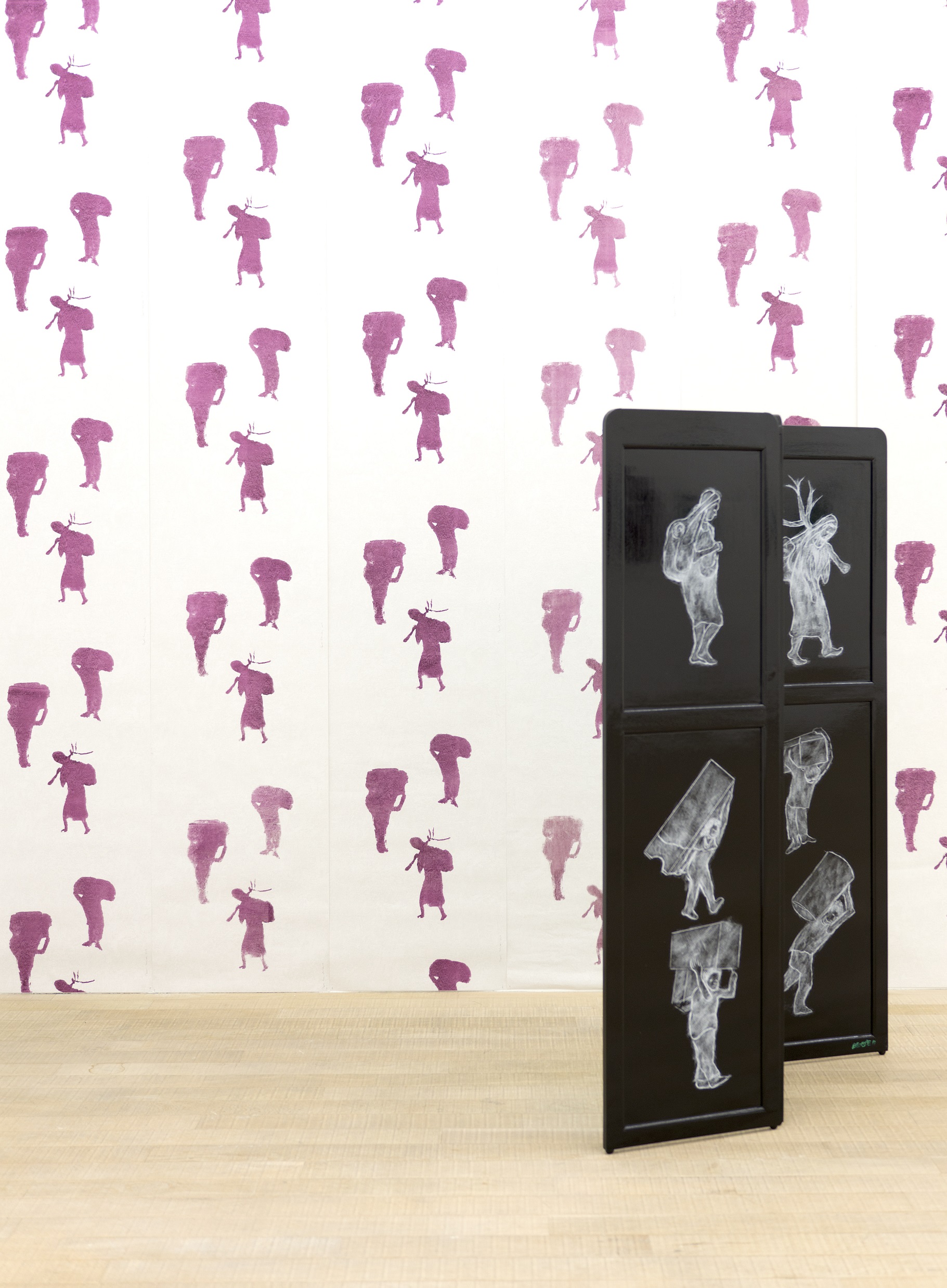
追放された壁紙
2017年
壁紙
サイズ可変
作家蔵
Papel de colgadura desplazados (Displaced Wallpaper)
2017
Wallpaper
Dimensions variable
Collection of the artist
追放された壁紙
2017年
壁紙
サイズ可変
作家蔵
壁紙に繰り返し印刷されたシルエットの人物は、肩の上に何か大きなものを載せて歩いています。これは、近年世界中のメディアが伝えた、ベネズエラから国境を越えてコロンビアへの入国を試みる人々の姿です。2010年代半ばより政治経済の状況が不安定なベネズエラから逃れようと、何百万もの人々がマットレスや洗濯機などの家財道具を背負いながら、川や険しい道を移動してきました。この難民危機は、多くのコロンビア人に、1970年代、彼らが自国の内戦から逃れようとした際、ベネズエラ政府に拒絶された過去を思い起こさせ、両国間に緊張をもたらしました。本作はシルエットを用いることで、特定の国際問題を批判しながらも、そこに含まれる個人の記憶や感情を匿名化し普遍的なものとして描いています。
Papel de colgadura desplazados (Displaced Wallpaper)
2017
Wallpaper
Dimensions variable
Collection of the artist
These silhouetted figures repeatedly printed on the wallpaper walk bearing a large load on their shoulders. These are the images of people attempting to cross the border from Venezuela into Colombia, which have been reported by media throughout the world in recent years. Since the mid-2010s, millions of people have fled Venezuela’s unstable political and economic situation, carrying mattresses, washing machines, and other household goods on their backs as they navigate rivers and steep roads. The refugee crisis has put many Colombians in mind of the 1970s, during which their attempts to flee their country’s civil war met with rejection by the Venezuelan government, and caused tensions between the two countries. By using silhouettes, this work mounts a criticism of a specific international issue, while at the same time anonymizing and universalizing the personal memories and emotions that it entails.
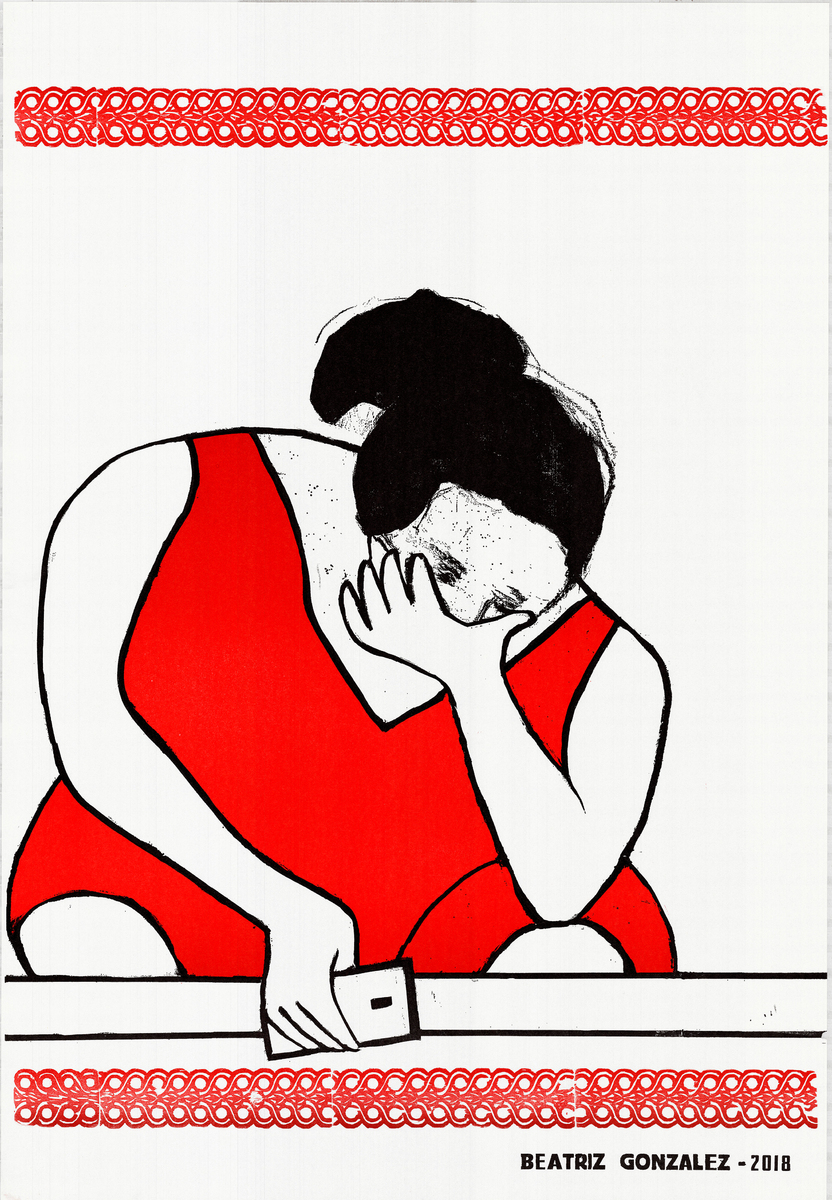
縁の下の嘆き―携帯電話を持って嘆く
2018年
デジタルプリント
100×70 cm
作家蔵
Zócalo del duelo—duelo con celular (Socle of the Mourning—Mourning with Cellphone)
2018
Digital print
100 x 70 cm
Collection of the artist
縁の下の嘆き―携帯電話を持って嘆く
2018年
デジタルプリント
100×70 cm
作家蔵
Zócalo del duelo—duelo con celular (Socle of the Mourning—Mourning with Cellphone)
2018
Digital print
100 x 70 cm
Collection of the artist
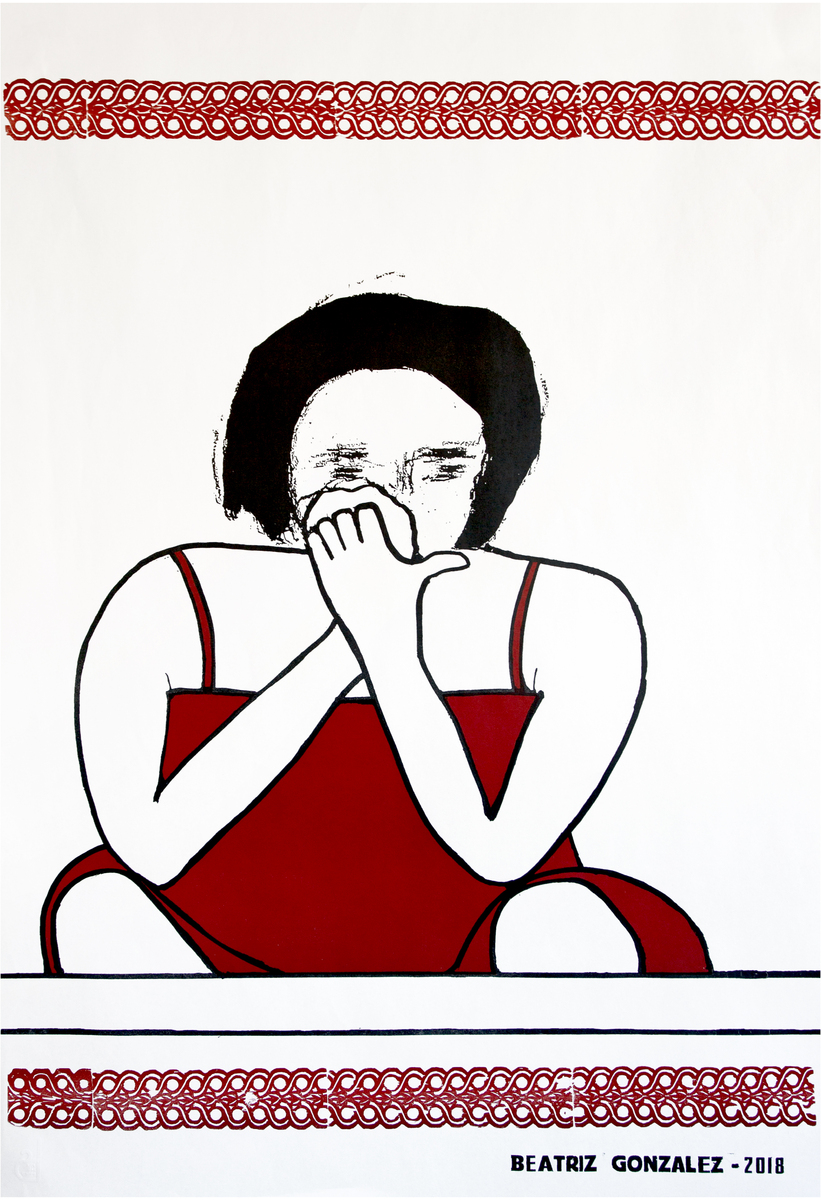
縁の下の嘆き―ハンカチを持って嘆く
2018年
デジタルプリント
100×70 cm
作家蔵
Zócalo del duelo—duelo con pañuelo (Socle of the Mourning—Mourning with Handkerchief)
2018
Digital print
100 x 70 cm
Collection of the artist
縁の下の嘆き―ハンカチを持って嘆く
2018年
デジタルプリント
100×70 cm
作家蔵
Zócalo del duelo—duelo con pañuelo (Socle of the Mourning—Mourning with Handkerchief)
2018
Digital print
100 x 70 cm
Collection of the artist
壁の低い位置に交互に貼られた2種類の絵柄のポスター。赤をまとった女性の一方は携帯電話を、もう片方はハンカチを持ちながら泣いています。絵柄は出品作《嘆きに直面して》と同様、コロンビアの新聞に頻繁に掲載された内戦の犠牲者を悼む市民の姿に基づいています。現地で「ソカロ(zócalo)」と呼ばれる幅木(床に接する壁の横板)の位置に並べられたポスターは、室内に限らず首都ボゴタの街中で数週間にわたり、広告を装って数百枚が掲出されました。新聞記事のイメージを引用しながら、彼女は言葉にし難い国家規模の悲劇に向き合い、死者を記憶していく術を模索しています。
Two posters of different designs have been pasted alternately at a low height on the wall. One of two women is clad in red and holds a cell phone, while the other is holding a handkerchief and crying. Similar to the work Ante el duelo (In the Face of Mourning), the design of this work is based on the frequent articles in Colombian newspapers about citizens mourning the victims of the civil war. Hundreds of posters masquerading as advertisements, placed like the baseboards (the side of the wall that touches the ground, and called zócalo by locals), were displayed not only indoors but also in the streets of the capital city of Bogotá for several weeks. By quoting images from newspaper articles, González confronts an unspeakable national tragedy and seeks a way to remember the dead.
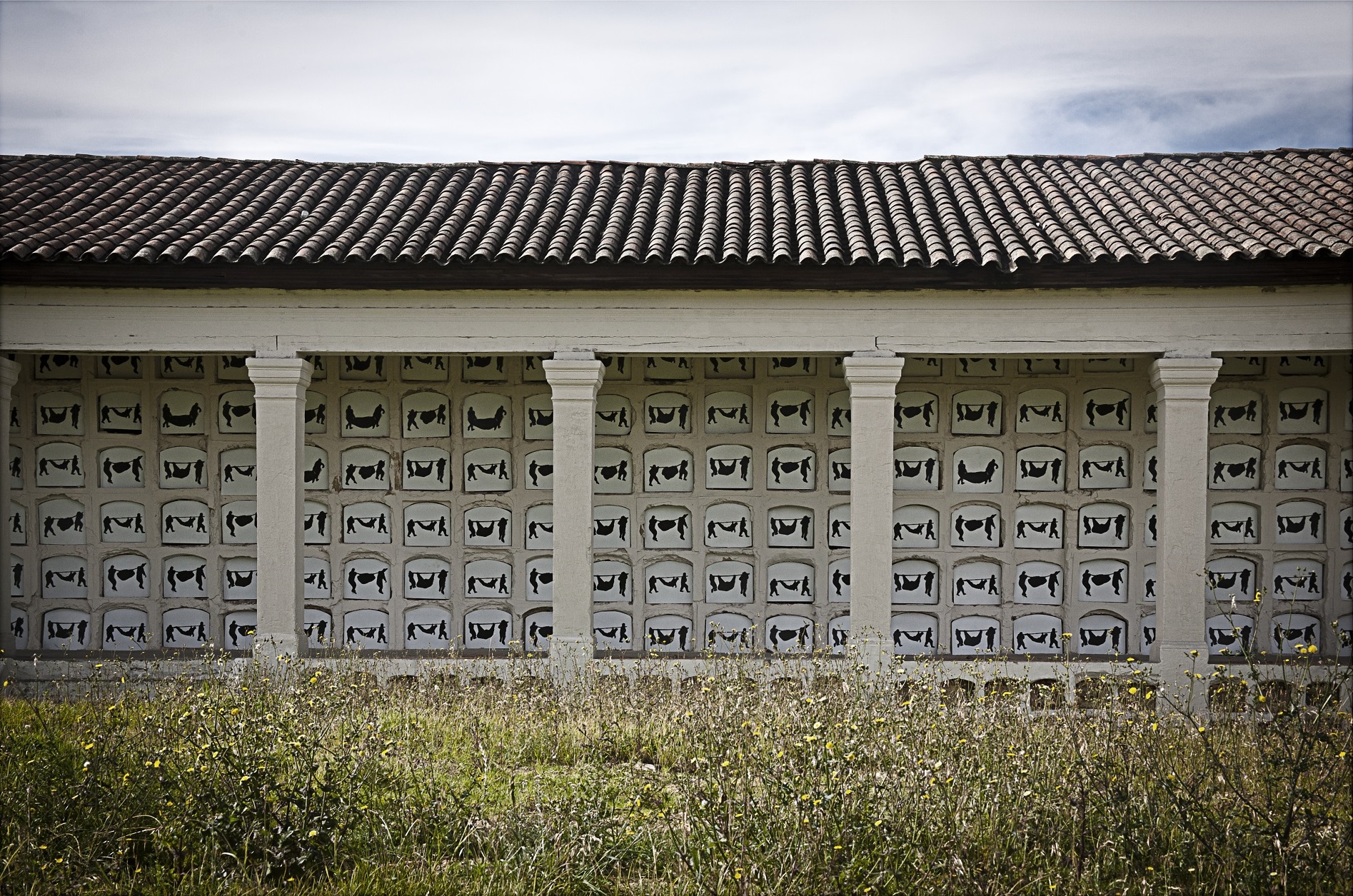
無名のオーラ
2007-2009年
写真複製
サイズ可変
作家蔵
展示風景:ボゴタ中央墓地(コロンビア) 2007-2009年
撮影:Laura Jiménez
Auras Anónimas (Anonymous Auras)
2007-2009
Photographic reproduction
Dimensions variable
Collection of the artist
Installation view: Central Cemetery of Bogotá, Colombia, 2007-2009
Photo: Laura Jiménez
無名のオーラ
2007-2009年
写真複製
サイズ可変
作家蔵
展示風景:ボゴタ中央墓地(コロンビア) 2007-2009年
壁一面に拡大された写真は、ボゴタ市の中央墓地で行った大型パブリック・アートの記録です。縦横に並んだ9000基近い墓は、70年以上前に建造されたもので、すでに中の遺体は移送されています。ゴンザレスは墓の開口部をひとつずつ白い板で塞ぎ、その上に黒い人影をシルクスクリーンで刷りました。出品作《ブカラマンガの運び人》にも描かれている2人組は、報道写真から引用されており、死体をハンモックに乗せて運び出す男たちです。 本作は、2003年に市の再開発により取り壊しが決まった墓地を、市民と記憶を共有する場として活用すべく、ゴンザレスがアーティストのドリス・サルセド(1958年-)と協働したプロジェクト「Lugar de memoria(記憶の場所)」の一環で制作されました。個人の存在や感情を軽視する自国の公権力に対し、彼女は無数の板に1枚ずつシルエットを刷ることで、名も無き死者たちを鎮魂すると同時に、社会が忘却していくそれぞれの痕跡をとどめようと試みています。中央墓地は長年にわたる行政への働きかけの結果、2019年に無期限に保存されることが決定されました。
Auras Anónimas (Anonymous Auras)
2007-2009
Photographic reproduction
Dimensions variable
Collection of the artist
Installation view: Central Cemetery of Bogotá, Colombia, 2007-2009
Photo: Laura Jiménez
The photo enlarged on the wall is a record of a large public art installation that González produced in a communal ossuary in the central cemetery in Bogotá. The nearly 9,000 tombs, lined up horizontally and vertically, were built more than seventy years ago, and the bodies inside have already been relocated. González covered the openings of the tombs one by one with white boards and silkscreened black human figures onto them. The pair, also depicted in the exhibited work Cargueros de Bucaramanga (Bucaramanga Porters), are taken from a press photo, are two men carrying a dead body out in a hammock. This work was created as part of the project “Lugar de memória (Place of Memory),” where González collaborated with artist Doris Salcedo (1958-) to use the cemetery, slated to be demolished in 2003 as part of the city’s redevelopment, as a place to share memories with the public. By printing silhouettes one by one on countless boards, González attempts to offer repose to the souls of the nameless dead, while at the same time preserving the traces of each individual that society consigns to oblivion. After years of lobbying the government, a decision was made in 2019 to conserve the cemetery indefinitely.
アーティスト一覧ARTISTS
- Etel Adnan|エテル・アドナン
- Phyllida Barlow|フィリダ・バーロウ
- Anna Boghiguian|アンナ・ボギギアン
- Miriam Cahn|ミリアム・カーン
- Lili Dujourie|リリ・デュジュリー
- Anna Bella Geiger|アンナ・ベラ・ガイゲル
- Beatriz González|ベアトリス・ゴンザレス
- Carmen Herrera|カルメン・ヘレラ
- Kim Soun-Gui|キム・スンギ
- Suzanne Lacy|スザンヌ・レイシー
- Mishima Kimiyo|三島喜美代
- Miyamoto Kazuko|宮本和子
- Senga Nengudi|センガ・ネングディ
- Nunung WS|ヌヌンWS
- Arpita Singh|アルピタ・シン
- Robin White|ロビン・ホワイト

